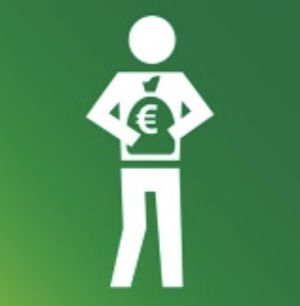Why even use segmentation for pricing and selling?
It’s accepted truth that one-size-fits-all pricing and selling is rarely the best way to conduct business. In fact, there’s only two alternatives to segmentation:
One-size-fits-all aka the big average: Take the average preference and build a product around it. This is like selling grey jelly babies – the average of yellow, red, green and white is grey, but grey would barely taste good to anyone. Unless you are the only one selling jelly candies, nobody will buy your grey candies. So if you don’t hold a monopoly, one-size-fits-all is not a good idea.
Segment of one: Give every customer the exact product they want. Even if you could handle the complexity as a provider, the customer will have a hard time making a decision, because, in many case, customers don’t even know what they actually want. One aspect of making customers decided is to reduce the complexity of choice options and tell them what type or customer they become when buying this or that option.
The same holds for pricing: There is always someone who will accept a higher price point than someone else for what is basically the same product. Depending on the unit economics of your business, there is likely much value in somehow charging both of them different prices to make both sales. That’s the idea behind price differentiation, and there are lots of valuable ideas and opinions on how to do it best. On the sales side of things, not every customer is won over by the same arguments. Every salesman can recall one of the many times when they knew afterwards that either or both product and sales pitch just didn’t resonate with the customer. Wouldn’t it be helpful to somehow know what sales pitch to use on which customer, preferably even ahead of time?
Now while we all dream of having complete knowledge of each individual customer and exactly how they decide and how much they’d accept to pay, that’s impossible, or very costly, and maybe even illegal to achieve.
That’s where segmentations come in: we can group up our customer base into segments that should (hopefully) be somewhat alike in their basic buying behavior. But right then it’s where things get complicated.
The three basic forms of segmentation
Chances are that you’ve come across a large number of different segmentations in your career in pricing, marketing and sales, all of them based on very different assumptions and very different data sources. Are they all created equal? Which ones have value for pricing and selling? Let’s have a shot at navigating you through the maze.
By and large, there are three major forms of customer segmentations out there:
- (Buyer) personas
- BI-based segmentations
- Scientific segmentations
Personas: Just dream on
The most en vogue form of segmentation that we typically see are buyer personas. What’s appealing about them is that they’re a way to systematize tacit knowledge about the customer already present in the organization, and make it operational. There are typically only 3 to 5 persona types, so they’re very easy to remember by the people who are supposed to use them. In short: Personas are a cost-effective method to create some kind of typology usable in the organization. Looking pretty good, right?
Well, it’s not that easy. The biggest problem with a persona typology is that the chance of it representing the customer base is very, very low. First, personas will always suffer from the biases of those people who came up with them. As personas relate to reality, the most outspoken (i.e. “noisy”) customers are typically most present in the typology. We know this to be true from our experience: Say, when we ask a B2B sales department to describe what the majority of their customers are like in the negotiation situation, that most are highly price sensitive and discount-focused. When we test that empirically, we are rarely if ever able to substantiate it (motivations such as loss aversion and complaisance play a role in B2B also).
Personas can only provide a slanted representation of the customer base. That’s true quantitatively, i.e. the relative shares of the types in the customer base will be off, and also qualitatively; personas will not reliably reveal the customer’s actual motivation in making decisions. We will need to base our typologies on data.
BI-based segmentations: all that glitters is not gold
Everyone collects data on their customers nowadays. Both simple and complex analytics tools are available to discover patterns in data with the aim of actually creating knowledge about one’s customers. The idea is that there must a treasure of gold somewhere in the ever-increasing mountains of data we all store.
If you clean customer data thoroughly and then spend enough time on the analysis, you can derive some decent customer segmentations from BI data. How much value they bring, however, depends completely on the quality and characteristics of the data you collect on your customers.
In fact, all that glitters is not gold.
At Vocatus, we base all the work we do on the idea that the main goal of pricing and selling is to influence decisions.
(If this idea does not ring true to you immediately, may I suggest that this might not be the blog for you …)
Now if we want a customer segmentation that helps us price and sell better, we need that segmentation to be all about the decisions that our customers make in relation to what we want to sell to them. To derive a segmentation from existing BI data, we need to make sure that the data we input is all about decisions also. Now that is easier said than done.
Most data that our clients want us to have a look at is a mix of transactional and usage data. With that we can rather accurately map the individual or collective journey our customers’ have had with us up to this point. But we cannot learn anything about what went on inside their heads at each stage of that journey. We know a great deal about what decisions have been made, but we know nothing about why our customers decide like they do. Any segmentation that is completely post-hocwill not help us much in influencing future decisions that our customers will make.
To actually influence decisions we need a segmentation that goes beyond just data of what our customer have purchased and used, and when.
Scientific segmentations: Beware of universal truth claims
Researchers form psychology, sociology, neuroscience and others fields have been busy trying to classify people by any number of characteristics. Let’s consider briefly what relevance some major scientific segmentations have for influencing decisions (which as we have established is basically all that pricing and selling is supposed to do).
The Big Five aspect scale
Let’s get this brainchild of personality psychology out of the way to start with. Needless to say, it’s not actually a segmentation. It’s just five dimensions of human personality of which we all have our very own unique combination. We only have to include it here because some of our clients have brought it up before.
Why are the Big Five little use for pricing and sales? To start, the Big Five are just not validly linked to buying behavior and purchase decisions. They have some validity in predicting life, relationship and career success, but they are not a good predictor of how customers go about choosing insurance or buying a car. Even if they held predictive power for purchasing behavior, the Big Five would just be too impractical to use in a pricing & sales context. There is just no way to accurately optimize for decision-making on five independent dimensions, let alone the endless possibility for placement on them.
That’s okay, because the Big Five were never intended to help anyone in a marketing, pricing or sales profession with their job. And that brings us to those typologies which were created to that.
Scientific typologies for marketing
There are a number of marketing typologies out there which are both empirically valid and useable in marketing.
In Germany (Vocatus’ home market) perhaps the most well-known are Gruppe Nymphenburg’s Lymbic® Types and the Sinus Institute’s Sinus Milieus®. Both help companies sharpen their branding and marketing orientation to be more customer-centric. They can help us understand who exactly our market is and how to target it. That’s great, as far as we are concerned.
So how about pricing and selling?
As all pricing and selling seeks to do is influence decisions, we believe a pricing and selling typology ought to be decision-based also – simple enough, right?
In our experience, almost all segmentations fall short here. To illustrate: Say a typology tells us that people who enjoy gardening are likely neurologically or sociologically different from people who are really into collecting high-end audio equipment. But suppose now we need to make either the gardener or the audio equipment collector decide for a specific choice of shovel or speaker at the point of sale. Does our scientific typology tell us how that customer will behave in relation to price and product comparisons? Does he or she need a discount, or do the product’s special features decide? Will we need to offer a warranty extension? How big is the role the price actually plays in the context of the decision?
If our segmentation doesn’t tell us that, we shouldn’t rely on it to help us price and sell.
As we looked around, we at Vocatus noticed that there simply wasn’t a typology around that could reliably predict decision behavior. The only solution was to get to work on finding one!
GRIPS: a true decision typology for pricing and sales
More than ten years ago, we at Vocatus started to think seriously about this whole segmentation maze.
We set ourselves the goal to create a typology, that is
- decision-focused, so is able to predict how customers will react to specific prices and offers
- based on Behavioral Economics, thus reflecting actual human behavior
- scientifically valid, meaning that it is the unbiased statistical result from data and has retest reliability
- universal, meaning that it’s applicable in all industries and around the world
- easy to grasp and thus usable and identifiable by everyone with customer contact (buyer personas anyone?)

Bargain Hunter
Selectively interested in discounts and gifts; loves to compare; chooses because of (and not in spite of) the price, loses sight of the total price

Risk Avoider
Disappointed or cautious consumer; more afraid of getting ripped off or losing something than getting any fun out of comparing prices

Price Accepter
Open to additional options and upselling if the value is made transparent to him; typically spends more than originally planned

Routine Buyer
Very loyal to a brand or provider; doesn’t want to invest time in making comparisons; has considerable degree of trust in brand and product promises

Indifferent Buyer
Not interested in prices or price comparisons and unaware of prices too – low-involvement customer primarily seeking a pragmatic solution in the moment
Over the past years, we have successfully applied GRIPS to a smorgasbord of markets, industries and customer touchpoints. There are a lot of ways how GRIPS can create value for your marketing organization, as
- the perfect basis for customer-centric products and product portfolios
- a powerful tool for performance marketing
- it streamlines and improves in-person and telephone sales by providing adaptive sales scripts that push the rights buttons with the customer
- it complements existing customer data and segmentations by adding the decision dimension they typically lack
Thus, this (somewhat) authoritative guide through the segmentation maze ends with a pitch of our own approach to segmenting. We’re convinced that for pricing and selling, there is simply no solution out there better than GRIPS.
Pricing and selling means influencing decisions – all pricing and selling strategies and the tools supporting them should reflect that.
Do you want to keep learning about how to make your pricing and selling more customer-decision-centered? Subscribe below!




